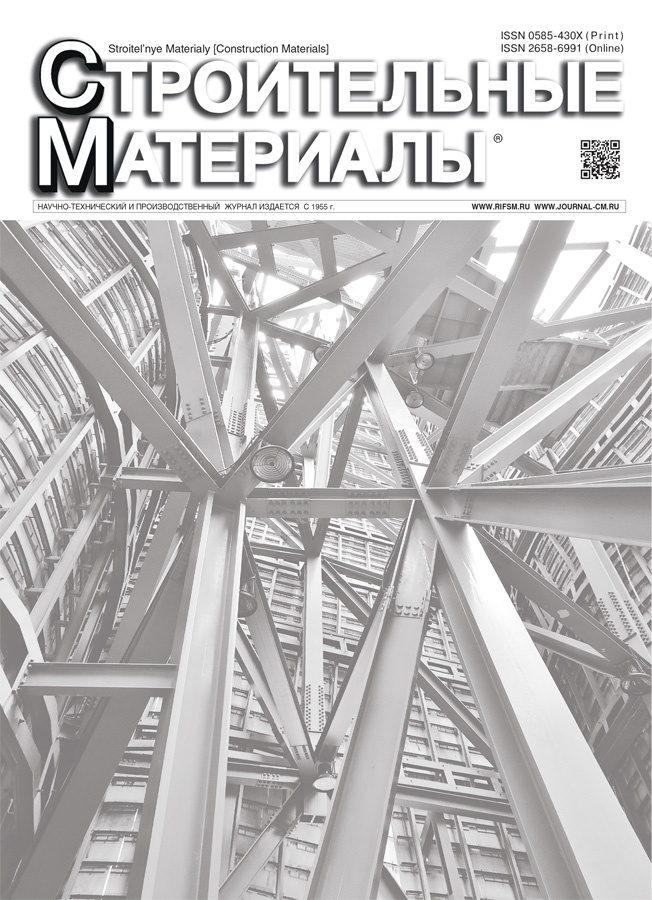Study of structural features and properties of composite cement-ash binders based cement stone
- Authors: Makarenko S.V.1, Khozin V.G.2
-
Affiliations:
- Irkutsk National Research Technical University
- Kazan State University of Architecture and Engineering
- Issue: No 9 (2025)
- Pages: 61-67
- Section: Статьи
- URL: https://freezetech.ru/0585-430X/article/view/693109
- DOI: https://doi.org/10.31659/0585-430X-2025-839-9-61-67
- ID: 693109
Cite item
Abstract
The article presents the studies results of the cement stone structure from composite binder (KV) based on Portland cement CEMI-42.5N (GOST 31108-2020) and hydraulically removed ashes from the Novo-Irkutsk Thermal Power Plant (hereinafter referred to as HRA). The HRA and cement stone (CS) structural characteristics are presented. The characteristics are obtained with the following methods of analysis: X-ray structural and X-ray fluorescence; TGA-thermogravimetric and petrographic, scanning electron microscopy (SEM). The dependences of the cement tile strength on the ratio of the binder components and their specific surface area, Ca(OH)2 content in the cement stone and chemically bound water have been established. It is shown that an increase in the HRA specific surface area relative to Portland cement increases the cement stone compressive strength (of all KV compositions), due to its pozzolanic activity. The HRA specific surface area priority over the Portland cement specific surface area allows make a favorable forecast of the developed binders economic efficiency since the HRA grindability is much higher than that of Portland cement, which significantly reduce energy consumption for grinding. That is why the developed KV compositions can be recommended for commercial concret and mortars production to be used in the construction complex of the Irkutsk region.
Full Text
About the authors
S. V. Makarenko
Irkutsk National Research Technical University
Author for correspondence.
Email: makarenko_83_07@mail.ru
Candidate of Sciences (Engineering), Docent
Russian Federation, 83, Lermontov Street, Irkutsk, 664074V. G. Khozin
Kazan State University of Architecture and Engineering
Email: khozin.vadim@yandex.ru
Doctor of Sciences (Engineering), Professor
Russian Federation, 1, Zelenaya Street, Kazan, 420043, Republic of TatarstanReferences
- Mikhailov Yu.V. New technologies of subsoil use, ensuring environmental and national security of Russia. Gornyj Informacionno-Analiticheskij Byulleten’. 2018. No. 11, pp. 92–106. (In Russian). EDN: YLZPIT. https://doi.org/10.25018/0236-1493-2018-11-0-92-106
- Vatin N.I., Petrosov D.V., Kalachev A.I., Lakhtinen P. Use of ashes and ash and slag waste in construction. Magazine of Civil Engineering. 2011. No. 4, pp. 16–21. (In Russian). EDN: NVYMZJ
- Pichugin E.A. Analytical review of the accumulated experience in the Russian Federation of involving ash and slag waste from thermal power plants in economic circulation. Problemy Regional’noj Ekologii. 2019. No. 4, pp. 77–87. (In Russian). EDN: MNEMSX. https://doi.org/10.24411/1728-323X-2019-14077
- Rakhimov R.Z. Fuel and energy complex, ecology and mineral binders. Izvestiya KSUACE. 2022. No. 3 (61), pp. 67–74. (In Russian). EDN: GVGCSA. https://doi.org/10.52409/20731523_2022_3_67
- Heidrich C., Feuerbonr H.J,, Weir A. Coal combustions products: a global perspective. International Conference on Mechanical Engineering and Renewable Energy. 2013, pp. 22–23.
- Bryukhan F.F. Use of ash and slag waste from coal-fired thermal power plants for the production of building materials. Actual problems of the construction industry and education: Collection of reports of the 1st National Conf. Moscow, 2020, pp. 225–228. (In Russian). EDN: PNHKNW.
- Haleem A., Luthra S., Mannan B. et al.Critical factors for the successful usage of fly ash in roads & bridges and embankments: Analyzing Indian perspective. Resources Policy. 2016. Vol. 49, pp. 334–348. http://dx.doi.org/10.1016/j.resourpol.2016.07.002
- Markov A.Yu., Strokova V.V., Markova I.Yu. Evaluation of the properties of fuel ash as components of composite materials. Stroitel’nye Materialy [Construction Materials]. 2019. No. 4, pp. 77–83. (In Russian). EDN: PNTEQW. https://doi.org/10.31659/0585-430X-2019-769-4-77-83
- Da Silva S.R., Jairo José de Oliveira Andrade. A review on the effect of mechanical properties and durability of concrete with construction and demolition waste (CDW) and fly ash in the production of new cement concrete. Sustainability. 2022. Vol. 14 (11). 6740. EDN: IBGSLM. https://doi.org/10.3390/su14116740
- Raheel M., Rahman F., Ali Q. A stoichiometric approach to find optimum amount of fly ash needed in cement concrete. SN Applied Sciences. 2020. Vol. 2. 1100. EDN: OCJXGQ. https://doi.org/10.1007/s42452-020-2913-y
- Kalashnikov V.I., Suzdal’cev O.V., Dryanin R.A., Sekhposyan G.P. The role of dispersed and fine-grained fillers in new generation concretes. Izvestiya of Higher Educational Institutions. Stroitel’stvo. 2014. No. 7 (667), pp. 11–21. (In Russian). EDN: SZGIBB.
- Yavinsky A.V., Chulkova I.L. Influence of the specific surface area of hydraulic ash removal on the properties of ash-cement stone. Promyshlennoe i Grazhdanskoe Stroitel’stvo. 2023. No. 2, pp. 73–80. (In Russian). EDN: GTKWZF. https://doi.org/10.33622/0869-7019.2023.02.73-80
- Yavinsky A.V., Chulkova I.L. Kinetics of strength gain of a mixed binder. Bulletin of the Siberian State Automobile and Highway University. 2023. Vol. 20. No. 1 (89), pp. 158–166. (In Russian). EDN: NYKJTH. https://doi.org/10.26518/2071-7296-2023-20-1-158-166
- Makarenko S.V., Khozin V.G. Prospects for the use of ash from hydraulic removal of the Irkutsk region as the main component of composite cement binders. Tekhnika i Tekhnologiya Silikatov. 2025. Vol. 32. No. 2, pp. 195–204. (In Russian). EDN: WVNUAA. https://doi.org/10.62980/2076-0655-2025-195-204
- Batrakov V.G. Modificirovannye betony. Teoriya i praktika [Modified concrete. Theory and practice]. 2nd ed. revised and supplemented. Moscow: Technoproekt, 1998. 768 p. EDN: ZTDODP
Supplementary files


















